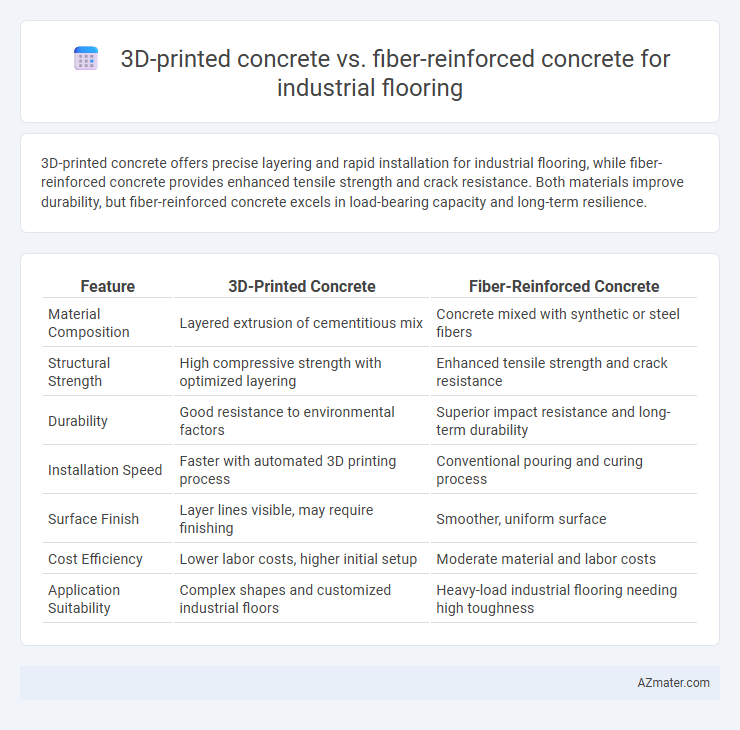3D-printed concrete offers precise layering and rapid installation for industrial flooring, while fiber-reinforced concrete provides enhanced tensile strength and crack resistance. Both materials improve durability, but fiber-reinforced concrete excels in load-bearing capacity and long-term resilience.
Table of Comparison
| Feature | 3D-Printed Concrete | Fiber-Reinforced Concrete |
|---|---|---|
| Material Composition | Layered extrusion of cementitious mix | Concrete mixed with synthetic or steel fibers |
| Structural Strength | High compressive strength with optimized layering | Enhanced tensile strength and crack resistance |
| Durability | Good resistance to environmental factors | Superior impact resistance and long-term durability |
| Installation Speed | Faster with automated 3D printing process | Conventional pouring and curing process |
| Surface Finish | Layer lines visible, may require finishing | Smoother, uniform surface |
| Cost Efficiency | Lower labor costs, higher initial setup | Moderate material and labor costs |
| Application Suitability | Complex shapes and customized industrial floors | Heavy-load industrial flooring needing high toughness |
Introduction to Modern Industrial Flooring Solutions
3D-printed concrete offers precise customization and rapid installation, revolutionizing modern industrial flooring with complex geometric designs and reduced labor costs. Fiber-reinforced concrete enhances durability and crack resistance, providing superior load-bearing capacity essential for heavy industrial use and extended service life. Both materials contribute to sustainable construction practices by minimizing waste and improving structural performance in industrial flooring applications.
What is 3D-Printed Concrete?
3D-printed concrete is an innovative construction material extruded layer-by-layer through additive manufacturing technology to create complex shapes without traditional formwork, enhancing design flexibility and reducing material waste. This method enables rapid, cost-effective production of industrial flooring with precise control over geometry and structural integrity. Unlike fiber-reinforced concrete, which incorporates fibers for improved tensile strength and crack resistance, 3D-printed concrete excels in customization and speed, making it ideal for tailored industrial flooring solutions.
Understanding Fiber-Reinforced Concrete
Fiber-reinforced concrete (FRC) enhances industrial flooring by integrating synthetic or steel fibers that improve tensile strength, crack resistance, and durability compared to traditional concrete. Unlike 3D-printed concrete, which relies on layer-by-layer deposition and rapid setting, FRC provides superior impact resistance and load-bearing capacity essential for heavy industrial use. Optimizing fiber type, dosage, and distribution within the concrete matrix is critical to achieving enhanced structural performance and longevity in industrial flooring applications.
Comparative Strength and Durability
3D-printed concrete offers precise layering and customization, leading to consistent compressive strength ranging from 30 to 50 MPa, whereas fiber-reinforced concrete incorporates steel or synthetic fibers that enhance tensile strength and toughness, reducing crack propagation. Fiber-reinforced concrete demonstrates superior durability in industrial flooring applications by resisting impact loads and thermal expansion better than conventional concrete, while 3D-printed concrete's durability depends heavily on print quality and material composition. Comparative studies reveal that fiber-reinforced concrete better withstands long-term mechanical stress, whereas 3D-printed concrete excels in design flexibility but requires optimization for similar durability under industrial conditions.
Installation Speed and Process Efficiency
3D-printed concrete significantly enhances installation speed for industrial flooring by automating layer-by-layer deposition, reducing labor costs, and minimizing curing time compared to traditional methods. Fiber-reinforced concrete requires conventional pouring and finishing, making the process slower and more labor-intensive despite improved durability. Process efficiency in 3D printing benefits from precise material usage and reduced waste, while fiber-reinforced concrete relies on skilled workmanship to ensure consistent fiber distribution and optimal performance.
Customization and Design Flexibility
3D-printed concrete offers unparalleled customization and design flexibility for industrial flooring by enabling complex geometries and intricate patterns that are difficult to achieve with traditional methods. Fiber-reinforced concrete enhances structural performance and durability but is limited in creating highly tailored shapes due to conventional casting processes. The additive nature of 3D printing supports rapid prototyping and on-demand modifications, making it ideal for projects requiring precise, adaptable designs.
Cost Analysis: 3D-Printed vs Fiber-Reinforced Flooring
3D-printed concrete offers significant cost advantages in industrial flooring by reducing labor costs and material waste through automated, precise application methods. Fiber-reinforced concrete typically incurs higher material expenses due to the added fibers and requires conventional pouring and finishing labor, which increases overall installation costs. While 3D printing may involve higher initial equipment investment, its potential for faster project completion and lower lifecycle maintenance costs makes it a more cost-effective solution in large-scale industrial flooring applications.
Sustainability and Environmental Impact
3D-printed concrete for industrial flooring reduces material waste and lowers carbon emissions due to precise material placement and optimized mix designs, promoting sustainable construction practices. Fiber-reinforced concrete enhances durability and longevity, decreasing maintenance frequency and resource consumption over time, contributing to environmental conservation. Comparing both, 3D-printed concrete offers innovative waste minimization and energy efficiency, while fiber reinforcement ensures extended service life with reduced ecological footprint.
Maintenance and Long-Term Performance
3D-printed concrete offers precise layering and reduced waste, but its maintenance can be challenging due to potential layer delamination and surface roughness requiring periodic sealing for industrial flooring. Fiber-reinforced concrete enhances durability and crack resistance by integrating synthetic or steel fibers, resulting in lower maintenance needs and superior long-term performance under heavy industrial loads. Combining fiber reinforcement with advanced 3D-printing techniques can optimize wear resistance and structural integrity, extending the lifespan of industrial floors.
Choosing the Right Technology for Industrial Flooring
3D-printed concrete offers precise shaping and rapid installation, making it ideal for complex industrial flooring designs requiring customization and speed. Fiber-reinforced concrete enhances durability and crack resistance, providing superior load-bearing capacity critical for heavy machinery and high-traffic zones. Selecting the right technology depends on project-specific factors such as design complexity, load requirements, and installation timeframe to optimize performance and cost-efficiency.

Infographic: 3D-printed concrete vs fiber-reinforced concrete for industrial flooring
 azmater.com
azmater.com